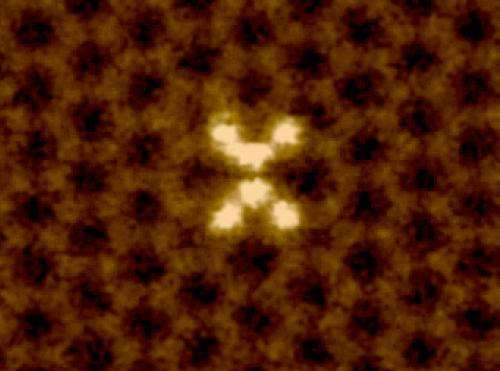ORNL microscopy uncovers 'dancing' silicon atoms in graphene

(Phys.org) —Jumping silicon atoms are the stars of an atomic scale ballet featured in a new Nature Communications study from the Department of Energy's Oak Ridge National Laboratory.
The ORNL research team documented the atoms' unique behavior by first trapping groups of silicon atoms, known as clusters, in a single-atom-thick sheet of carbon called graphene. The silicon clusters, composed of six atoms, were pinned in place by pores in the graphene sheet, allowing the team to directly image the material with a scanning transmission electron microscope.
The "dancing" movement of the silicon atoms, seen in a video below, was caused by the energy transferred to the material from the electron beam of the team's microscope.
"It's not the first time people have seen clusters of silicon," said coauthor Juan Carlos Idrobo. "The problem is when you put an electron beam on them, you insert energy into the cluster and make the atoms move around. The difference with these results is that the change that we observed was reversible. We were able to see how the silicon cluster changes its structure back and forth by having one of its atoms 'dancing' between two different positions."
Other techniques to study clusters are indirect, says Jaekwang Lee, first author on the ORNL study. "With the conventional instrumentation used to study clusters, it is not yet possible to directly identify the three-dimensional atomic structure of the cluster," Lee said.
The ability to analyze the structure of small clusters is important for scientists because this insight can be used to precisely understand how different atomic configurations control a material's properties. Molecules could then be tailored for specific uses.
"Capturing atomic clusters inside patterned graphene nanopores could potentially lead to practical applications in areas such as electronic and optoelectronic devices, as well as catalysis," Lee said. "It would be a new approach to tuning electronic and optical properties in materials."
The ORNL team confirmed its experimental findings with theoretical calculations, which helped explain how much energy was required for the silicon atom to switch back and forth between different positions.
More information: The study, published as "Direct visualization of reversible dynamics in a Si6 cluster embedded in a graphene pore," is available online here: www.nature.com/ncomms/journal/ … full/ncomms2671.html
Journal information: Nature Communications
Provided by Oak Ridge National Laboratory





















